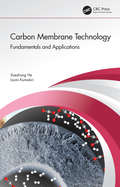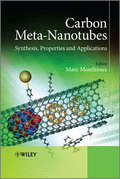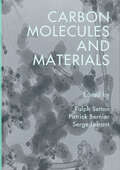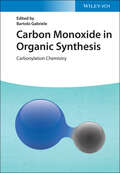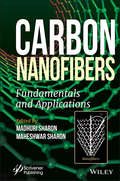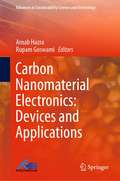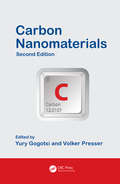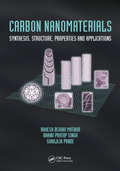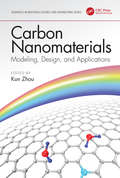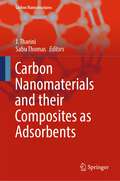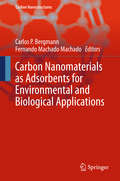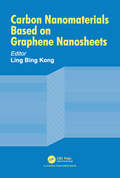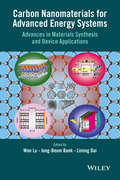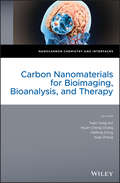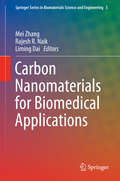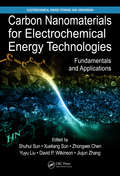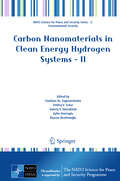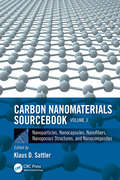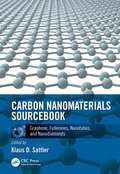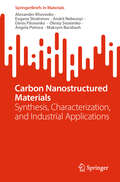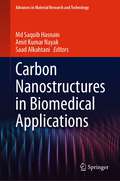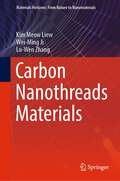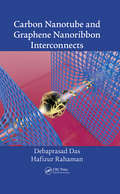- Table View
- List View
Carbon Membrane Technology: Fundamentals and Applications
by Xuezhong He Izumi KumakiriCarbon membranes have great advantages of strong mechanical strength and high chemical stabilities, as well as high separation performance to reach the industrial attractive region. Further improvement on membrane performance can potentially offset the relatively high production cost compared to polymeric membranes. However, there are still some challenges related to fabrication of asymmetric carbon membranes, the controlling of structure and pore-size and module up-scaling for commercial application. The aim of this book is to provide the fundamentals on carbon membrane materials for the young researchers and engineers to develop frontier membrane materials for energy efficient separation process. This book describes the status and perspectives of both self-supported and supported carbon membranes from fundamentals to applications. The key steps on the development of high performance carbon membranes including precursor selection, tuning carbon membrane structure and regeneration are discussed. In the end, different potential applications both in gas and liquids separation are well described, and the future directions for carbon membrane development were pointed out. To this end, membrane science and engineering are set to play crucial roles as enabling technologies to provide energy efficient and cost-effective future solutions for energy and environment related processes. Based on this approach the research projects which are trying to find attractive carbon materials in our days are many. The published papers, per year, in the topic of carbon membranes, especially for biogas upgrading, natural gas sweetening and hydrogen purification, are numerous with very high impact. However, only few are the books which include relevant to the topic of carbon membrane technology. This book offers the condensed and interdisciplinary knowledge on carbon membranes, and provides the opportunity to the scientists who are working in the field of carbon membrane technology for gas and liquid separations to present, share, and discuss their contributions within the membrane community.
Carbon Meta-Nanotubes
by Marc MonthiouxMeta-Nanotubes are a new generation of carbon nanotubes (CNTs) which result from the chemical transformation of regular CNTs and their subsequent combination with foreign materials (atoms, molecules, chemical groups, nanocrystals) by various ways such as functionalisation, doping, filling, and substitution. These new nanomaterials exhibit enhanced or new properties, such as reactivity, solubility, and magnetism, which pristine CNTs do not possess. Their many applications include electronic and optoelectronic devices, chemical and biosensors, solar cells, drug delivery, and reinforced glasses and ceramics.Carbon Meta-Nanotubes: Synthesis, Properties and Applications discusses these third generation carbon nanotubes and the unique characteristics they possess. Beginning with a general overview of the subject, this book covers the five main categories of meta-nanotubes, namely:Doped Carbon Nanotubes Functionalised Carbon Nanotubes Decorated or Coated Carbon Nanotubes Filled Carbon Nanotubes Heterogeneous Nanotubes Providing unparalleled coverage of these third generation or meta-nanotubes, and possibilities for future development, this book is essential for anyone working on carbon nanotubes.
Carbon Molecules and Materials
by Ralph Setton Patrick Bernier Serge LefrantThe unexpected recent discovery and synthesis of a new form of elemental carbon has initiated an abundance of papers on all aspects of the chemistry and physics of the carbon family. Carbon Molecules and Materials takes stock of the current understanding of these various solid forms and, more particularly, of the diamond, graphite and fullerenes. A
Carbon Monoxide in Organic Synthesis: Carbonylation Chemistry
by Bartolo GabrieleA thoroughly up-to-date overview of carbonylation reactions in the presence of carbon monoxide In Carbon Monoxide in Organic Synthesis: Carbonylation Chemistry, expert researcher and chemist Bartolo Gabriele delivers a robust summary of the most central advances in the field of carbonylation reactions in the presence of carbon monoxide. Beginning with a brief introduction on the importance of carbon monoxide as a building block in modern organic synthesis, the author goes on to describe metal-catalyzed carbonylations utilizing iron, cobalt, nickel, copper, and manganese. Descriptions of palladium, ruthenium, and rhodium-catalyzed reactions follow, as do discussions of metal-free carbonylation processes. The book is organized by metal to make the book useful as a guide for researchers from both academia and industry whose work touches on the direct synthesis of carbonyl compounds, carboxylic acid derivatives, and heterocycles. It aims to stimulate further discoveries in this rapidly developing field. Readers will also enjoy: A thorough introduction to carbonylations promoted by first row transition metal catalysts, including cobalt-catalyzed and nickel-catalyzed carbonylations An exploration of carbonylations promoted by second row transition metal catalysts, including ruthenium-, rhodium-, palladium(0)-, and palladium(II)-catalyzed carbonylations Practical discussions of miscellaneous carbonylation reactions, including carbonylations promoted by third row transition metal catalysts and metal-free carbonylation processes Perfect for catalytic and organic chemists, Carbon Monoxide in Organic Synthesis: Carbonylation Chemistry is also an indispensable resource for chemists working with organometallics and industrial chemists seeking a summary of important processes used to synthesize value-added products.
Carbon Nanofiber Reinforced Polymer Composites (SpringerBriefs in Materials)
by Nikhil Gupta Ronald L. PovedaThis book presents an extensive review of literature on the properties of carbon nanofibers (CNF) reinforced polymer composites in conjunction with advances in the production and properties of CNFs. It further provides readers a view into the development of lightweight composites whose properties are tailored and enhanced with micro- and nano-reinforcement, along with results from data comparisons from several published investigations.
Carbon Nanofibers: Fundamentals and Applications (Advances in Nanotechnology and Applications)
by Madhuri Sharon Maheshwar SharonThis book covers the fundamentals and applications of Carbon Nanofiber (CNF). In the first section, the initial chapter on the fundamentals of CNF is by Professor Maheshwar Sharon, the recognized “Father of Carbon Nanotechnology in India”, which powerfully provides a succinct overview of CNFs. This is followed by a chapter on biogenics that have produced unique morphologies of CNF that makes them suitable to various applications. This is followed by a chapter that mainly focuses on nanocomposites, especially those involving nanocomposites of CNF. The role of nanocatalysts and composites in promoting and enhancing the synthesis and application of CNF is then covered, followed by an important chapter on the characterization of CNF. The second section of the book encompasses the various applications of CNF, such as its use as a possible superconductor to adsorb and store hydrogen, and as a microwave absorber. The application of CNF for environmental concerns is also detailed by assessing its usefulness in dye and heavy metal removal from polluted water. The applications that are addressed include lithium-ion battery, solar cell, antenna, cosmetics, usefulness in regenerative medicine, as well as various aspects of agrotechnology.
Carbon Nanomaterial Electronics: Devices and Applications (Advances in Sustainability Science and Technology)
by Arnab Hazra Rupam GoswamiThis book brings together selective and specific chapters on nanoscale carbon and applications, thus making it unique due to its thematic content. It provides access to the contemporary developments in carbon nanomaterial research in electronic applications. Written by professionals with thorough expertise in similar broad area, the book is intended to address multiple aspects of carbon research in a single compiled edition. It targets professors, scientists and researchers belonging to the areas of physics, chemistry, engineering, biology and medicine, and working on theory, experiment and applications of carbon nanomaterials.
Carbon Nanomaterials (Advanced Materials and Technologies)
by Yury Gogotsi Volker PresserThis book provides information on synthesis, properties, and applications of carbon nanomaterials. With novel materials, such as graphene (atomically flat carbon) or carbon onions (carbon nanospheres), the family of carbon nanomaterials is rapidly growing. This book provides a state-of-the-art overview and in-depth analysis of the most important ca
Carbon Nanomaterials: Synthesis, Structure, Properties and Applications
by Rakesh Behari Mathur Bhanu Pratap Singh Shailaja PandeThe study of nanostructures has become, in recent years, a theme common to many disciplines, in which scientists and engineers manipulate matter at the atomic and molecular level in order to obtain materials and systems with significantly improved properties. Carbon nanomaterials have a unique place in nanoscience owing to their exceptional thermal, electrical, chemical, and mechanical properties, finding application in areas as diverse as super strong composite materials, energy storage and conversion, supercapacitors, smart sensors, targeted drug delivery, paints, and nanoelectronics. This book is the first to cover a broad spectrum of carbon nanomaterials, namely carbon nanofibers, vapor-grown carbon fibers, different forms of amorphous nanocarbons besides carbon nanotubes, fullerenes, graphene, graphene nanoribbons, graphene quantum dots, etc. in a single volume.
Carbon Nanomaterials: Modeling Design And Applications (Advances in Materials Science and Engineering)
by Kun ZhouCarbon Nanomaterials: Modeling, Design, and Applications provides an in-depth review and analysis of the most popular carbon nanomaterials, including fullerenes, carbon nanotubes, graphene and novel carbon nanomaterial-based membranes and thin films, with emphasis on their modeling, design and applications. This book provides basic knowledge of the structures, properties and applications of carbon-based nanomaterials. It illustrates the fundamental structure-property relationships of the materials in both experimental and modeling aspects, offers technical guidance in computational simulation of nanomaterials, and delivers an extensive view on current achievements in research and practice, while presenting new possibilities in the design and usage of carbon nanomaterials. This book is aimed at both undergraduate and graduate students, researchers, designers, professors, and professionals within the fields of materials science and engineering, mechanical engineering, applied physics, and chemical engineering.
Carbon Nanomaterials and their Composites as Adsorbents (Carbon Nanostructures)
by Sabu Thomas J. ThariniThis book elucidates fundamental concepts of nanomaterials and their pivotal role as nanoadsorbents in water purification. Key features include the latest trends in adsorption for metal, micro pollutants, food adulterants, aromatic compounds, pesticides, dyes, and oil particle removal. Additionally, the interdisciplinary aspects of adsorption and practical applications for hazardous chemical removal from water are explored. The book delves into various types of adsorption isotherms such as Langmuir, Freundlich, BET, and others, offering a deep understanding for water purification. Kinetic models including first, second, and third order kinetics are elucidated, empowering undergraduate students to grasp and optimize complex systems. The required background is basic knowledge in chemistry, biology, mathematics, and nanoscience at the first-year university level. Designed for both academics and industrial researchers, this book is divided into 17 chapters. Chapters 1-7 introduce nanomaterials, carbon nanoadsorbents, their synthesis, and surface modification. Chapters 8-9 cover fundamental adsorption isotherms, kinetic models, thermodynamic parameters, adsorption mechanism, and experimental techniques. Chapters 10-15 delve into the adsorption and desorption of various compounds like aromatic compounds, pesticides, heavy metals, micro pollutants, food adulterants, oil particles, and dyes molecules. The final chapter tackles the theoretical modeling of carbon nanomaterials for adsorption studies
Carbon Nanomaterials as Adsorbents for Environmental and Biological Applications (Carbon Nanostructures)
by Carlos P. Bergmann Fernando Machado MachadoThis book presents a summary of the current use of carbon nanomaterials for water treatment, drug delivery, systems and nanosensors. The first chapter elucidates the adsorption process phenomenon. Also, the properties of different carbon nanomaterials for adsorption applications are covered. The third chapter presents the kinetic and equilibrium models of adsorption, processing of experimental data and adsorption process peculiarities. Environmental and biological applications of carbon nanomaterials are listed in the last chapter. This book is written from an application-oriented perspective and is useful for all those interested in nanoadsorbents.
Carbon Nanomaterials Based on Graphene Nanosheets
by Ling Bing KongSince the discovery of graphene, it has become one of the most widely and extensively studied materials. This book aims to summarize the progress in synthesis, processing, characterization and applications of a special group of nanocarbon materials derived from graphene or graphene related derivatives by using various strategies in different forms. More specifically, three forms of macrosized materials are presented, i.e., one-dimension or 1D (fibers, wires, yarns, streads, etc.), two-dimension or 2D (films, membranes, papers, sheets, etc.) and three-dimension or 3D (bulk, hydrogels, aerogels, foams, sponges, etc.). Seven chapters are included with the first chapter serving to introduce the concept, definition, and nomenclature of graphene, graphene oxide and their derivatives. The main topics are covered in Chapters 2‒7. Although they have coherent connections, each chapter of them is designed such that they can be studied independently. The target readers of this book include undergraduate students, postgraduate students, researchers, designers, engineers, professors, and program/project managers from the fields of materials science and engineering, applied physics, chemical engineering, biomaterials, materials manufacturing and design, institutes, and research founding agencies.
Carbon Nanomaterials for Advanced Energy Systems
by Jong-Beom Baek Wen Lu Liming DaiWith the proliferation of electronic devices, the world will need to double its energy supply by 2050. This book addresses this challenge and discusses synthesis and characterization of carbon nanomaterials for energy conversion and storage. Addresses one of the leading challenges facing society today as we steer away from dwindling supplies of fossil fuels and a rising need for electric power due to the proliferation of electronic products Promotes the use of carbon nanomaterials for energy applications Systematic coverage: synthesis, characterization, and a wide array of carbon nanomaterials are described Detailed descriptions of solar cells, electrodes, thermoelectrics, supercapacitors, and lithium-ion-based storage Discusses special architecture required for energy storage including hydrogen, methane, etc.
Carbon Nanomaterials for Bioimaging, Bioanalysis, and Therapy (Nanocarbon Chemistry and Interfaces)
by Yuen Y. Hui Huang-Cheng Chang Haifeng Dong Xueji ZhangA comprehensive reference on biochemistry, bioimaging, bioanalysis, and therapeutic applications of carbon nanomaterials Carbon nanomaterials have been widely applied for biomedical applications in the past few decades, because of their unique physical properties, versatile functionalization chemistry, and biological compatibility. This book provides background knowledge at the entry level into the biomedical applications of carbon nanomaterials, focusing on three applications: bioimaging, bioanalysis, and therapy. Carbon Nanomaterials for Bioimaging, Bioanalysis and Therapy begins with a general introduction to carbon nanomaterials for biomedical applications, including a discussion about the pros and cons of various carbon nanomaterials for the respective therapeutic applications. It then goes on to cover fluorescence imaging; deep tissue imaging; photoacoustic imaging; pre-clinical/clinical bioimaging applications; carbon nanomaterial sensors for cancer and disease diagnosis; targeted cancer therapy; and photothermal/photodynamic therapy. Each chapter briefly introduces the biomedical application and emphasizes the most appropriate carbon nanomaterial(s) for the application. Provides an introduction to the biomedical applications of carbon nanomaterials for early-career scientists, as well as background and context for mid-career scientists and researchers Contains four sections covering biochemistry, bioimaging, bioanalysis, and therapeutic applications of carbon nanomaterials Presented by experts who have strong background in the field of nanotechnology for biomedical applications Covers a hot area of research which has very unique physical properties, versatile functionalization chemistry, and biological compatibility Carbon Nanomaterials for Bioimaging, Bioanalysis and Therapy is an excellent resource for academic researchers and industrial scientists working on preparation and bio-application of carbon nanomaterials, biomedical engineering, and nanotechnology.
Carbon Nanomaterials for Biomedical Applications (Springer Series in Biomaterials Science and Engineering #5)
by Liming Dai Mei Zhang Rajesh R. NaikThis book covers a wide range of topics relating to carbon nanomaterials, from synthesis and functionalization to applications in advanced biomedical devices and systems. As they possess unique and attractive chemical, physical, optical, and even magnetic properties for various applications, considerable effort has been made to employ carbon nanomaterials (e. g. , fullerenes, carbon nanotubes, graphene, nanodiamond) as new materials for the development of novel biomedical tools, such as diagnostic sensors, imaging agents, and drug/gene delivery systems for both diagnostics and clinical treatment. Tremendous progress has been made and the scattered literature continues to grow rapidly. With chapters by world-renowned experts providing an overview of the state of the science as well as an understanding of the challenges that lie ahead, Carbon Nanomaterials for Biomedical Applications is essential reading not only for experienced scientists and engineers in biomedical and nanomaterials areas, but also for graduate students and advanced undergraduates in materials science and engineering, chemistry, and biology.
Carbon Nanomaterials for Electrochemical Energy Technologies: Fundamentals and Applications (Electrochemical Energy Storage and Conversion)
by Shuhui Sun Xueliang Sun Zhongwei Chen Yuyu Liu David P. Wilkinson Jiujun ZhangThis book offers comprehensive coverage of carbon-based nanomaterials and electrochemical energy conversion and storage technologies such as batteries, fuel cells, supercapacitors, and hydrogen generation and storage, as well as the latest material and new technology development. It addresses a variety of topics such as electrochemical processes, materials, components, assembly and manufacturing, degradation mechanisms, challenges, and strategies. With in-depth discussions ranging from electrochemistry fundamentals to engineering components and applied devices, this all-inclusive reference offers a broad view of various carbon nanomaterials and technologies for electrochemical energy conversion and storage devices.
Carbon Nanomaterials in Clean Energy Hydrogen Systems - II (NATO Science for Peace and Security Series C: Environmental Security)
by Ayfer Veziroğlu Beycan İbrahimoğlu Dmitry V. Schur Svetlana Yu. Zaginaichenko Valeriy V. SkorokhodThis book presents selected contributions to the NATO Advanced Research Workshop "Carbon Nanomaterials in Clean Energy Hydrogen Systems" held in June 2010. These original papers reflect recent progress in response to the modern-day requirements in chemistry of carbon nanomaterials and metal-hydrogen systems. Successor to the 2008 proceedings, this second volume focuses on research and application studies of materials capable of interacting actively with hydrogen, also addressing questions of hydrogen accumulation and storage. As a whole, it provides a review of the most relevant areas of hydrogen materials interactions and carbon nanomaterials science, making it invaluable for all researchers, physicists, chemists, post-graduates and young scientists interested in the structure, properties and applications of different nanocarbon materials.
Carbon Nanomaterials Sourcebook: Nanoparticles, Nanocapsules, Nanofibers, Nanoporous Structures, and Nanocomposites, Volume II
by Klaus D. SattlerThe Carbon Nanomaterials Sourcebook contains extensive, interdisciplinary coverage of carbon nanomaterials, encompassing the full scope of the field—from physics, chemistry, and materials science to molecular biology, engineering, and medicine—in two comprehensive volumes. Written in a tutorial style, this second volume of the sourcebook: Focuses on nanoparticles, nanocapsules, nanofibers, nanoporous structures, and nanocomposites Describes the fundamental properties, growth mechanisms, and processing of each nanomaterial discussed Explores functionalization for electronic, energy, biomedical, and environmental applications Showcases materials with exceptional properties, synthesis methods, large-scale production techniques, and application prospects Provides the tools necessary for understanding current and future technology developments, including important equations, tables, and graphs Each chapter is dedicated to a different type of carbon nanomaterial and addresses three main areas: formation, properties, and applications. This setup allows for quick and easy search, making the Carbon Nanomaterials Sourcebook: Nanoparticles, Nanocapsules, Nanofibers, Nanoporous Structures, and Nanocomposites a must-have reference for scientists and engineers.
Carbon Nanomaterials Sourcebook: Graphene, Fullerenes, Nanotubes, and Nanodiamonds, Volume I
by Klaus D. SattlerThe Carbon Nanomaterials Sourcebook contains extensive, interdisciplinary coverage of carbon nanomaterials, encompassing the full scope of the field-from physics, chemistry, and materials science to molecular biology, engineering, and medicine-in two comprehensive volumes.Written in a tutorial style, this first volume of the sourcebook:Focuses on g
Carbon Nanostructured Materials: Synthesis, Characterization, and Industrial Applications (SpringerBriefs in Materials)
by Maksym Barabash Alexander Khovavko Eugene Strativnov Andrii Nebesnyi Denis Filonenko Olexiy Sviatenko Angela PiatovaThis book provides a concise yet comprehensive look at carbon nanostructured materials, focusing on synthesis methodologies, applications, and fundamental principles. Based on extensive research conducted at the Gas Institute of the National Academy of Sciences of Ukraine, it offers a thorough examination of recent advancements in the field. The book describes various synthesis techniques, particularly emphasizing the continuous synthesis of carbon nanotubes (CNTs) on metal catalysts using chemical vapor deposition (CVD). It also discusses computational fluid dynamics (CFD) modeling of heating processes associated with carbon materials, crucial for understanding the thermodynamics of complex gas systems relevant to CNTs synthesis. Furthermore, the book discusses the structural properties of carbon nanomaterials, employing techniques such as Raman spectroscopy and optical microscopy. It provides detailed insights into the design and optimization of modern equipment for CNTs synthesis, with a focus on energy-efficient reactors for thermally expanded graphite (TEG) production. Beyond synthesis methodologies, the book explores applications of carbon nanomaterials, including their use in lithium-ion batteries, water purification systems, and nuclear reactors. It offers a serious examination of the potential environmental and technological implications of these materials. Comprising three distinct parts, each supplemented with comprehensive summaries, this book serves as a valuable resource for researchers, engineers, and graduate students in material science, thermal engineering, and nanotechnology. It presents empirical findings, theoretical insights, and practical applications, establishing itself as a valuable addition to the literature in the field of carbon nanostructured materials.
Carbon Nanostructures in Biomedical Applications (Advances in Material Research and Technology)
by Md Saquib Hasnain Amit Kumar Nayak Saad AlkahtaniThis book provides a holistic compilation on applications of carbon nanostructures, especially in advanced healthcare applications. It comprises chapters on utility of diverse multifunctional nanocarriers in drug delivery and biomedical applications, especially emphasizing on the synthesis and characterizations of nanosystems along with surface engineering approaches used for active targeting of the drugs. Moreover, the chapters also include the recent updates on the applications of the nanocarriers to fulfill the needs of various healthcare systems.
Carbon Nanothreads Materials (Materials Horizons: From Nature to Nanomaterials)
by Kim Meow Liew Wei-Ming Ji Lu-Wen ZhangThis book describes carbon nanothreads with complete and comprehensive knowledge covering theories, numerical methods, and properties comparisons with other carbon-based nanomaterials. For one thing, the main theoretical aspects in this book include: First-Principle Calculation, Density Functional Theory, Classical Molecular Dynamics Simulation, Non-equilibrium Molecular Dynamics Simulation, and Coarse Grained Simulation. For another thing, the main research contents include: Fundamental Mechanical Properties; Fracture Characteristics; Electronic and Magnetic Properties; Thermal Properties; Reinforcement in Polymer Composites; and other promising applications in engineering. The target of this book is to provide to many researchers the available theoretical and numerical methods, and useful computational results of carbon nanothreads for reference. This book can be used as a comprehensive source for scientists, academics, researchers, and engineers in various areas of engineering, physical sciences, and computational modeling. In order to achieve this target, the book introduces the microstructure information of carbon nanothreads and the modeling details at full length. The tunable mechanisms of physical properties of carbon nanothreads are discussed in detail, which enable integration of these nanoscale components into high-order structures for “bottom-up design” purpose. The revealed reinforced mechanisms of carbon nanothreads in polymer composites can provide theoretical guidance for engineering design of advanced polymer composites.
Carbon Nanotube and Graphene Device Physics
by H.-s. Philip Wong Deji AkinwandeThe medieval Norse-Icelandic saga is one of the most important European vernacular literary genres of the Middle Ages. This Introduction to the saga genre outlines its origins and development, its literary character, its material existence in manuscripts and printed editions, and its changing reception from the Middle Ages to the present time. Its multiple sub-genres - including family sagas, mythical-heroic sagas and sagas of knights - are described and discussed in detail, and the world of medieval Icelanders is powerfully evoked. The first general study of the Old Norse-Icelandic saga to be written in English for some decades, the Introduction is based on up-to-date scholarship and engages with current debates in the field. With suggestions for further reading, detailed information about the Icelandic literary canon, and a map of medieval Iceland, this book is aimed at students of medieval literature and assumes no prior knowledge of Scandinavian languages.
Carbon Nanotube and Graphene Nanoribbon Interconnects
by Debaprasad Das Hafizur RahamanAn Alternative to Copper-Based Interconnect Technology With an increase in demand for more circuit components on a single chip, there is a growing need for nanoelectronic devices and their interconnects (a physical connecting medium made of thin metal films between several electrical nodes in a semiconducting chip that transmit signals from one point to another without any distortion). Carbon Nanotube and Graphene Nanoribbon Interconnects explores two new important carbon nanomaterials, carbon nanotube (CNT) and graphene nanoribbon (GNR), and compares them with that of copper-based interconnects. These nanomaterials show almost 1,000 times more current-carrying capacity and significantly higher mean free path than copper. Due to their remarkable properties, CNT and GNR could soon replace traditional copper interconnects. Dedicated to proving their benefits, this book covers the basic theory of CNT and GNR, and provides a comprehensive analysis of the CNT- and GNR-based VLSI interconnects at nanometric dimensions. Explore the Potential Applications of CNT and Graphene for VLSI Circuits The book starts off with a brief introduction of carbon nanomaterials, discusses the latest research, and details the modeling and analysis of CNT and GNR interconnects. It also describes the electrical, thermal, and mechanical properties, and structural behavior of these materials. In addition, it chronicles the progression of these fundamental properties, explores possible engineering applications and growth technologies, and considers applications for CNT and GNR apart from their use in VLSI circuits. Comprising eight chapters this text: Covers the basics of carbon nanotube and graphene nanoribbon Discusses the growth and characterization of carbon nanotube and graphene nanoribbon Presents the modeling of CNT and GNR as future VLSI interconnects Examines the applicability of CNT and GNR in terms of several analysis works Addresses the timing and frequency response of the CNT and GNR interconnects Explores the signal integrity analysis for CNT and GNR interconnects Models and analyzes the applicability of CNT and GNR as power interconnects Considers the future scope of CNT and GNR Beneficial to VLSI designers working in this area, Carbon Nanotube and Graphene Nanoribbon Interconnects provides a complete understanding of carbon-based materials and interconnect technology, and equips the reader with sufficient knowledge about the future scope of research and development for this emerging topic.
